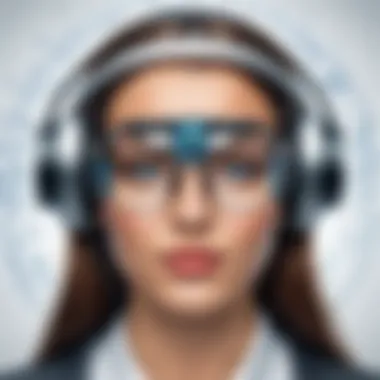Exploring Computer Vision Recognition: Key Insights and Trends


Intro
Computer vision recognition is a vital area within artificial intelligence, focusing on enabling machines to interpret visual data accurately. This technology has evolved significantly, affecting how we interact with digital systems. Understanding the key concepts, algorithms, and applications of computer vision offers insight into its capabilities and limitations. As we move forward in this article, we will explore the foundational principles and their implications for various industries.
Software Overview
Software Description
In the realm of computer vision recognition, software tools play a crucial role. These software systems are designed to process visual information from images and videos, extracting meaningful data. Commonly used frameworks like OpenCV, TensorFlow, and PyTorch provide robust libraries that facilitate the implementation of computer vision techniques. Each of these tools varies in functionality, intended use cases, and ease of integration.
Key Features
When assessing software for computer vision tasks, notable features may include:
- Image Processing: Algorithms to enhance and modify images effectively.
- Object Detection: Ability to identify and classify objects within a visual frame.
- Facial Recognition: Specialized features for identifying individuals based on facial attributes.
- Real-Time Analysis: Capability to process visual data in real-time, crucial for applications like surveillance systems or automated driving.
These features enable a wide array of applications across numerous industries.
User Experience
User Interface and Design
A usable interface is paramount for software focusing on computer vision. User experiences can be greatly enhanced with clear visual representations of data and results. Simplified navigation tools allow users, regardless of expertise levels, to manipulate and evaluate results effectively. Innovators in the industry prioritize user-centric designs that facilitate straightforward user interactions.
Performance and Reliability
Performance in computer vision software refers to its ability to deliver consistent and accurate results under varying conditions. Factors such as processing speed and reliability during real-world applications are critical. Users expect the software to perform well in diverse environments, from detecting objects in contrasting light conditions to processing images from sensors.
"The effectiveness of computer vision technology hinges on the balance between performance and user experience."
In summary, understanding computer vision recognition requires a grasp of both the underlying software capabilities and the user experience it provides. The developments in algorithmic efficiency and UI design contribute greatly to its practical applications and acceptance across industries.
Preface to Computer Vision Recognition
Computer vision recognition stands as a critical element within the larger framework of artificial intelligence. It concerns methods and processes through which machines interpret visual data. In today's tech-driven world, the ability to analyze and understand images and videos is indispensable for numerous applications, ranging from healthcare to retail.
Understanding the fundamentals of computer vision recognition aids in grasping how these technologies function effectively and what benefits they offer. Various industries rely on these capabilities to streamline operations, enhance user experiences, and uncover valuable insights from visual data. As a result, this exploration into computer vision recognition is not only beneficial but essential for IT professionals, software developers, and businesses alike.
Defining Computer Vision
Computer vision can be broadly defined as the field of study focused on enabling computers to interpret and understand visual information from the surrounding environment. It involves transforming images into actionable information, which can be processed by algorithms. The goal is to emulate human visual perception in a way that machines can generate outputs based on their observations.
A crucial function of computer vision is to analyze images and videos, enabling applications in facial recognition, object detection, image classification, and more. These processes are foundational to technologies that can enhance user interactions and automate decisions based on visual input.
Historical Context
The roots of computer vision recognition can be traced back to several decades ago. Initially, the field stemmed from traditional image processing techniques and evolved significantly with advancements in computer science and artificial intelligence. The first significant breakthroughs took place in the 1960s, when early researchers started exploring algorithms that could describe shapes and patterns in images.
The integration of machine learning in the 1990s propelled computer vision research forward. This new approach allowed systems to learn directly from image data, rather than relying solely on predefined rules. Over the years, the development of Convolutional Neural Networks marked a turning point, enabling new capabilities in the automation of image recognition tasks. This progression has led us to the present day, where computer vision is integral to many innovative applications.
Core Principles of Computer Vision
Understanding the core principles of computer vision is fundamental for grasping how machines interpret and analyze visual information. These principles not only underpin the technology itself but also guide the practical applications across various sectors. By dissecting the essential elements of computer vision, we can better appreciate its capabilities and significance in contemporary technology. Critical aspects include image processing fundamentals and the integration of machine learning, which together create a robust framework for developing advanced recognition systems.
Image Processing Fundamentals
Image processing involves the manipulation of images to enhance their quality or extract useful information. It plays a vital role in computer vision recognition as it prepares raw data for machine learning models. Key techniques in image processing include filtering, edge detection, and image transformation, which allow for more accurate analysis.
Benefits of Image Processing in Computer Vision:
- Improvement in Clarity: Enhanced images lead to better recognition results.
- Noise Reduction: Removes irrelevant information that could confuse algorithms.
- Feature Extraction: Allows models to focus on critical components of the image.
These processes lay the foundation for more complex tasks, ensuring data is clean and interpretable before further analysis.
Machine Learning Integration
Machine learning is crucial for optimizing computer vision recognition systems. It allows computers to learn from data and improve their performance over time without being explicitly programmed. This integration can be divided into three main categories: supervised learning, unsupervised learning, and reinforcement learning.


Supervised Learning
Supervised learning involves training a model on a labeled dataset, where the correct output is provided for each input. This method is particularly beneficial because it allows the model to learn associations between input images and their corresponding labels.
Key Characteristics:
- Data Driven: Requires a large amount of labeled data to train effectively.
- High Accuracy: When sufficient data is available, it typically yields high performance.
Advantages of Supervised Learning:
- Understands complex patterns effectively.
- Ties directly to clear objectives, enhancing outcome reliability.
However, it can be limited by the availability of labeled data and the need for expert input to create these datasets.
Unsupervised Learning
Unsupervised learning operates on unlabeled data. The model tries to identify patterns and group similar images without prior knowledge of the outcomes. This approach is beneficial when labeled data is scarce or unavailable.
Key Characteristics:
- Data Exploration: Useful for discovering hidden structures in data.
- Flexibility: Can adapt to various types of data without predefined categories.
Advantages of Unsupervised Learning:
- Reduces the need for extensive data labeling.
- Can suggest additional features for further analysis.
However, the challenge lies in validating the outputs generated by the model, as there are no correct labels to compare against.
Reinforcement Learning
Reinforcement learning focuses on training an agent to make decisions based on rewards and penalties. This method is vital in environments where interaction occurs, as the model learns optimal actions through trial and error.
Key Characteristics:
- Interactive Learning: Adapts to real-time feedback.
- Goal-Oriented: Aims to maximize cumulative reward.
Advantages of Reinforcement Learning:
- Ideal for dynamic situations where context changes frequently.
- Utilizes real-world scenarios to refine actions.
Yet, its complexity increases as it requires a well-defined reward structure, and the learning process can be slower due to exploration needs.
Understanding these machine learning techniques enriches our grasp of computer vision's potential, allowing IT professionals, software developers, and businesses to harness this technology effectively. Engaging with these principles prepares practitioners to explore further applications and advances in the domain.
Key Algorithms in Computer Vision Recognition
Computer vision recognition relies heavily on various algorithms that enable machines to process visual data effectively. These algorithms provide the foundation for systems to identify, classify, and understand visual inputs. Understanding these key algorithms—and their strengths and weaknesses—can be crucial for developers and businesses looking to implement computer vision solutions.
The right choice of algorithm can tremendously influence system performance, accuracy, and efficiency. For any organization, utilizing these algorithms can lead to improved product automation and enhanced user experiences. This section of the article will break down some pivotal algorithms that serve as the backbone of computer vision recognition technologies.
Convolutional Neural Networks
Convolutional Neural Networks (CNNs) are a class of deep learning algorithms specifically designed for visual recognition tasks. They are notable for their ability to automatically detect and learn features from images. This architecture mimics the way the human brain processes visual information. With multiple layers of processing, CNNs have the capacity to recognize intricate patterns and distinctions among different image objects.
Key characteristics of CNNs include:
- Layered Architecture: These networks have layers, including convolutional layers, pooling layers, and fully connected layers, each of which performs distinct functions for analyzing image data.
- Feature Learning: CNNs automatically learn features hierarchically, which means they can abstract complex patterns without manual feature extraction.
The benefit of using CNNs is their scalability and adaptability to various visual tasks, making them a preferred choice for many applications.
Image Segmentation Techniques
Image segmentation involves breaking down an image into parts or segments that are easier to analyze. It is a crucial step in understanding the content of images because it enables the identification of objects and boundaries. Advanced segmentation techniques can yield precise information, which is essential for tasks such as tracking and recognition.
Common techniques include:
- Thresholding: Simplifies images by converting them into binary formats.
- Edge Detection: Identifies the outlining of objects by detecting discontinuities in brightness.
While traditional methods have their strengths, newer approaches based on machine learning offer improved accuracy and adaptability in different environments.


Object Detection Algorithms
Object detection algorithms aim to locate objects within images and classify them accordingly. They serve various purposes, from security monitoring to user interaction interfaces.
YOLO (You Only Look Once)
YOLO is a state-of-the-art object detection algorithm known for its speed and efficiency. Unlike older object detection systems that look at the image multiple times, YOLO looks at the image only once, making it remarkably fast.
Key characteristics of YOLO:
- Real-Time Detection: Its speed allows for usage in real-time applications, such as video surveillance.
- Unified Architecture: YOLO uses a single neural network to predict bounding boxes and class probabilities simultaneously.
The unique feature of YOLO is its ability to maintain accuracy while processing images rapidly. Its advantages lie in the ability to achieve effective detection in various complex environments. However, it can struggle in situations with small objects or dense crowds.
SSD (Single Shot MultiBox Detector)
The SSD algorithm also aims to perform object detection in real-time. It employs a single-shot model to predict multiple bounding boxes and their corresponding classes simultaneously.
Key characteristics of SSD include:
- Multi-Scale Feature Maps: This allows SSD to detect objects of different scales effectively.
- Speed and Accuracy: SSD provides a good balance between speed and detection accuracy.
The unique feature of SSD is its ability to operate well on a variety of object sizes, making it versatile for deployment in various applications. One challenge, however, is that it tends to perform slightly better on larger objects than smaller ones.
"Understanding these algorithms is crucial for effective implementation in technology applications, enabling more accurate and useful outcomes."
Applications of Computer Vision Recognition
The impact of computer vision recognition technology spans various sectors, altering operations and enhancing efficiencies. Its applications are integral to how industries address challenges and innovate in their efforts. By utilizing image processing and AI algorithms, organizations can now automate processes that were once tedious and error-prone. This not only leads to increased productivity but also fosters new levels of precision. Ultimately, the importance of computer vision lies in its ability to provide real-time insights and automated solutions that can fundamentally reshape workflows.
Healthcare Innovations
Computer vision has remarkably influenced the healthcare sector, particularly through diagnostics and treatment planning. By analyzing medical images such as X-rays, MRIs, and CT scans, algorithms can identify anomalies that human eyes might miss. This capability leads to faster and more accurate diagnoses, which is critical for effective patient care. For example, deep learning models trained on vast datasets can detect tumors or fractures. As a result, clinicians can initiate treatments sooner, potentially improving patient outcomes.
Additionally, tools like AI-driven image analysis are becoming common, allowing for consistent monitoring of chronic conditions. The ability to process data quickly plays a significant role in advancements for telemedicine as well.
Automotive Industry Applications
Autonomous Vehicles
Autonomous vehicles represent one of the most exciting applications of computer vision. The technology enables vehicles to interpret and respond to their environments, mapping surroundings in real-time. Using extensive sensor data, including cameras and LIDAR, these vehicles can navigate safely without human intervention.
A key characteristic of autonomous vehicles is the ability to continuously learn. They analyze countless scenarios during operation, improving performance over time. This capacity for rapid learning makes them suitable for busy urban environments, where conditions can change frequently. However, challenges persist, including regulatory and ethical considerations surrounding safety and accountability.
Tire Pressure Monitoring Systems
Tire pressure monitoring systems (TPMS) also leverage computer vision technology. These systems track tire pressure, ensuring that automobiles operate under optimal conditions. A notable feature is their integration with dashboard alerts. This allows drivers to receive real-time updates on tire health.
The significant advantage of TPMS is enhanced safety. By reducing the chances of blowouts or tire failures, they protect both drivers and pedestrians. Nonetheless, improper calibrations or sensor issues can lead to false alerts, which is a disadvantage requiring ongoing refinement of the technology.
Retail Sector Enhancements
In the retail world, computer vision enhances customer experiences through improved inventory management and personalized shopping. Automated checkout systems reduce the need for cashiers, offering a quicker, seamless experience for consumers. Moreover, retailers employ surveillance and analytics tools to study consumer behavior, allowing for more targeted marketing strategies.
The benefit here is clear: optimized operations can lead to increased sales and customer satisfaction. However, ethical considerations around data privacy must be considered, ensuring that the use of technology aligns with consumer trust and expectations.
In summary, the applications of computer vision recognition are extensive and varied, cultivating innovations across sectors. Its role in enhancing efficiency and efficacy continues to evolve, marking a substantial shift in how businesses operate.
Challenges in Computer Vision Recognition
Understanding the challenges in computer vision recognition is crucial for the ongoing development and application of this technology. As it stands, several specific elements pose significant roadblocks. These issues not only hinder the effectiveness of recognition systems, but they also impact their usability in various fields. Addressing these challenges can lead to more reliable, efficient, and ethically sound systems.
Data Quality Issues
Data quality is a primary concern in computer vision recognition. The performance of recognition algorithms heavily relies on the data used for training. Poor quality data can lead to inaccurate models. This inaccuracy arises from several sources, including inadequate image resolution, mislabeling, and lack of diversity in datasets. For instance, using images that are not representative of real-world conditions can result in poor algorithm performance when applied in practice.
Key characteristics of data quality issues include:
- Inconsistent labeling: Mislabeling images can cause the algorithm to learn incorrect features, leading to errors in prediction.
- Diversity: Lack of diverse datasets can result in models that work well in controlled settings but fail under varied conditions.
- Image resolution: Low-quality images may not provide enough detail for effective analysis.


Addressing these concerns is essential to improve the reliability of recognition systems and enhance their applicability in real-world scenarios.
Real-Time Processing Constraints
Real-time processing is another significant challenge for computer vision recognition systems. Many applications, such as autonomous vehicles, demand instantaneous response from recognition algorithms. Fulfilling this requirement often proves problematic, especially when dealing with high-resolution images or complex models.
Several factors contribute to these processing constraints:
- Computational power: High-performance computations require advanced hardware, which may not always be accessible.
- Algorithm complexity: Some algorithms, while accurate, are computationally expensive and slow down processing times.
- Latency: Even slight delays in processing can compromise user experience or operational efficiency.
Improvements in processing capabilities are necessary to ensure that computer vision systems can function seamlessly in real-time environments.
Ethical Considerations
The ethical implications of computer vision recognition cannot be overlooked. This technology has the potential for misuse, leading to significant ethical dilemmas. Addressing these concerns is important, as it shapes the future application of computer vision in sensitive areas such as surveillance, healthcare, and personal privacy.
Bias in Algorithms
Bias in algorithms can lead to disparities in performance across different demographic groups. This characteristic highlights the importance of developing fairer models that do not inadvertently disenfranchise certain populations. Algorithms trained on biased datasets may perpetuate existing inequalities, reinforcing stereotypes and leading to harmful outcomes.
This aspect of bias illustrates:
- Discriminatory outcomes: If an algorithm is biased, it can lead to unfair treatment based on race, gender, or other attributes.
- Data representation: A lack of diverse training data can result in skewed results.
- Ethical responsibility: Developers must prioritize fairness in algorithm design to mitigate risks.
Privacy Concerns
Privacy is a significant concern associated with computer vision recognition. The ability of these systems to analyze and interpret visual data raises questions about how data is collected, stored, and used.
Key aspects of privacy concerns include:
- Data usage: AI systems may utilize personal data without proper consent, leading to privacy violations.
- Surveillance issues: The deployment of computer vision technology in public spaces can lead to unwarranted surveillance, impacting individual freedoms.
- Regulation: There is a need for clear regulations governing the usage of recognition technology to protect user privacy.
The Future of Computer Vision Recognition
The future of computer vision recognition is marked by significant developments that will profoundly impact various sectors. As technology evolves, the applications of computer vision become broader and more sophisticated. This section delves into emerging trends and potential market impacts, which will shape not only how we interact with machines but also enhance operational efficiencies across industries.
Emerging Trends
Integration with IoT
The integration of computer vision with the Internet of Things (IoT) is a critical area of growth. This relationship focuses on how interconnected devices can leverage visual recognition systems to gather data and provide insights. One key characteristic of this integration is its ability to enhance automation. For instance, smart security systems can utilize camera feeds for real-time detection and alerting.
A unique feature of this integration is the capability to monitor environments continuously, allowing for proactive decision-making. Businesses, especially in retail and logistics, benefit from enhanced inventory management and surveillance. However, challenges such as bandwidth requirements and data privacy issues must be considered.
Development of Explainable AI
The development of explainable AI is another important trend in computer vision. This concept emphasizes transparency in how algorithms make decisions. By providing insights into the processes underlying visual recognition, explainable AI fosters trust among users and stakeholders.
The key characteristic of explainable AI is its focus on interpretability. It allows developers and businesses to understand the reasoning behind the outcomes produced by computer vision systems. This is a beneficial aspect because it aids in compliance with regulations related to AI use. However, striking the right balance between algorithm complexity and interpretability remains a challenge.
Potential Market Impact
The market impact of advancements in computer vision recognition is expected to be substantial. Industries that adopt these technologies can improve efficiency, reduce costs, and enhance user experience. For example, in healthcare, optimized imaging systems are emerging to improve diagnostics and patient care.
Moreover, as organizations increasingly rely on computer vision, new business models will likely emerge. This shift could create opportunities for startups and established firms alike, leading to increased competition and innovation. With the potential to transform processes across sectors, computer vision recognition is not just a trend, but a fundamental shift in how businesses operate in the digital age.
Culmination
In the rapidly evolving landscape of technology, understanding computer vision recognition becomes increasingly important. This area of artificial intelligence not only enhances the interaction between machines and visual data but also significantly impacts various industries. The insights shared throughout this article underscore the significance of this field in advancing automation, improving user experience, and driving innovation.
Summarizing Key Points
The journey through computer vision recognition encompasses multiple disciplines and methodologies. Key points include:
- Defining computer vision as a means for machines to decode and interpret images and videos.
- Core principles that integrate image processing with machine learning, allowing systems to learn from and adapt to new visual information.
- Algorithms such as Convolutional Neural Networks and object detection methods like YOLO and SSD, which empower machines to achieve higher accuracy in recognition tasks.
- Real-world applications, from healthcare innovations to advancements in the automotive sector, illustrating the versatility of these technologies.
- Challenges that remain, especially in data quality, real-time processing, and ethical issues, which must be navigated carefully.
- Future opportunities through emerging trends in IoT and explainable AI, making the case for potential market impact.
Together, these elements paint a comprehensive picture of how computer vision recognition is set to transform our technological ecosystem.
Encouraging Further Exploration
Further exploration of this field is not just beneficial; it is essential. IT professionals, software developers, and businesses alike stand to gain considerable insights from delving deeper into the subject. Here are ways to engage:
- Continuous Education: Staying updated with the latest research and trends helps professionals maintain relevance in a fast-paced industry.
- Real-World Application: Testing algorithms and tools in practical scenarios can solidify understanding and improve implementation strategies.
- Ethical Engagement: Contributing to discussions on ethical considerations, such as biases in algorithms, ensures more responsible development of technologies.
- Collaboration: Engaging in forums and communities such as Reddit or following professional networks on platforms like Facebook fosters knowledge sharing.
As technology progresses, the ability to adapt and innovate through an understanding of computer vision recognition will be a cornerstone for all stakeholders involved.







